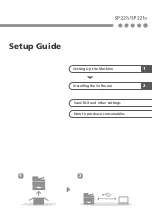
13–24
Chapter 13 – Troubleshooting Guide
a. There is a visible toner buildup on the OPC drum. Because the drum surface is coated
with photosensitive material, it is impractical to clean it. Replace the OPC drum unit.
b. The drum no longer holds a charge and is therefore not being cleaned correctly.
Replace the OPC drum unit.
635.
The fuser roller has excessive toner buildup or is worn out.
a. Occasionally, the fuser wiper becomes saturated with toner and does not clean the
fuser roller correctly. Toner builds up on the roller and then becomes burned onto it.
Replace the roller or fuser.
636.
The developer sleeve is not receiving the correct voltage. The ghosting is accompanied
by a dirty background in areas that should be white.
a. The contact between the developer sleeve and the contact spring from the H.V.P.S. is
faulty. Check for corrosion and a compressed spring. The contact may also be faulty
inside the developer unit itself. Replace the developer unit if the problem cannot be
corrected.
b. The H.V.P.S. is not supplying the correct voltage. Adjust it according to the procedure
in Chapter 8,
Power Supplies.
c. Replace the H.V.P.S. if the correct voltage cannot be obtained.
640.
Intermittent black patches.
641.
The H.V.P.S. is supplying intermittent voltages to the OPC drum. This usually results in
pages with intermittent black areas on them during the first 3 pages of a print job.
a. The H.V.P.S. is beginning to fail and must be replaced.
642.
The paper is dry and has static buildup.
a. In areas of very low humidity, the paper dries out and picks up excessive static charge
from the voltages in the printer. The paper must be stored at over 30% humidity in
order to avoid problems with excessive static buildup.
b. The plastic paper guide on the transfer charger can be replaced by one that is
conductive. These are available on an as-needed basis only. This is a very rare
occurrence.
c. The paper is defective and must be replaced. This is also very rare.
650.
Black spots on white print or white spots on black print.
These spots occur at random, and cover the entire page. It looks as if the page has a case of
the measles.
651.
The paper is dry and has static buildup.
a. In areas of very low humidity, the paper dries out and picks up excessive static charge
from the voltages in the printer. The paper must be stored at over 30% humidity in
order to avoid problems with static buildup.
b. The plastic paper guide on the transfer charger can be replaced by one that is
conductive. These are available on an as-needed basis only. This is a very rare
occurrence.
Summary of Contents for L1024
Page 1: ...R...
Page 2: ......
Page 3: ...R P N 704792 001 Rev C...
Page 18: ...1 8 Chapter 1 Introduction...
Page 19: ...2 1 Chapter 2 Clamshell Chapter 2 Clamshell Clamshell and Subassemblies...
Page 46: ...4 4 Chapter 4 Developer Subsystem...
Page 47: ...5 1 Chapter 5 Transfer Subsystem Chapter 5 Transfer Subsystem Transfer Charger...
Page 63: ...5 17 Chapter 5 Transfer Subsystem Detail 5 4 Removing the Lamp Connector...
Page 65: ...6 1 Chapter 6 Paper Feed Subsystem Chapter 6 Paper Feed Subsystem Paper Feed Subsystem...
Page 82: ...6 18 Chapter 6 Paper Feed Subsystem Step 3 Step 2 Detail 6 5 Removing Connectors...
Page 97: ...7 1 Chapter 7 Fuser Subsystem Chapter 7 Fuser Subsystem Fuser Subsystem...
Page 137: ...8 5 Chapter 8 Power Supplies 1 1 2 2 High Voltage Power Supply...
Page 144: ...8 12 Chapter 8 Power Supplies Figure 8 4 Removing the LVPS Cables...
Page 146: ...8 14 Chapter 8 Power Supplies 5 4 2 3 1 Figure 8 5 Removing the LVPS...
Page 147: ...8 15 Chapter 8 Power Supplies Cable Routing Figure 8 6 LVPS Cable Routing...
Page 150: ...8 18 Chapter 8 Power Supplies Figure 8 9 Removing the LVPS Cables...
Page 152: ...8 20 Chapter 8 Power Supplies 5 4 2 3 1 Figure 8 10 Removing the LVPS...
Page 153: ...8 21 Chapter 8 Power Supplies Cable Routing Figure 8 11 LVPS Cable Routing...
Page 199: ...10 1 Chapter 10 Control Panel Chapter 10 Control Panel Keypad LCD Control Panel...
Page 215: ...11 9 Chapter 11 Laser Scanning Unit LSU Subsystem Detail 11 1 Removing the Top Cover...
Page 225: ...12 5 Chapter 12 Covers Frame and Backplane Board 14 1 15 1 21 1 Hinge Covers...
Page 250: ...12 30 Chapter 12 Covers Frame and Backplane Board Figure 12 12 Removing Cables...
Page 252: ...12 32 Chapter 12 Covers Frame and Backplane Board 5 4 2 3 1 Figure 12 13 Removing the LVPS...
Page 269: ...12 49 Chapter 12 Covers Frame and Backplane Board Figure 12 27 Removing Cables...
Page 319: ...Appendix B Wire Data B 1 Appendix B Wire Data...
Page 322: ...Appendix B Wire Data B 4...
Page 327: ...C 5 Appendix C Continuous Form Stacker 15 2 10 1 Figure C 2...
Page 331: ...C 9 Appendix C Continuous Form Stacker 35 2 40 1 55 1 50 1 45 1 Figure C 4...
Page 333: ...C 11 Appendix C Continuous Form Stacker 60 2 Figure C 5...
Page 337: ...C 15 Appendix C Continuous Form Stacker 100 1 105 2 115 1 110 1 ROTATED 180 Figure C 7...
Page 349: ...C 27 Appendix C Continuous Form Stacker 1 2 Figure C 16 Removing the Vertical Frame Braces...
Page 371: ......
Page 372: ...704792 001C...
















































